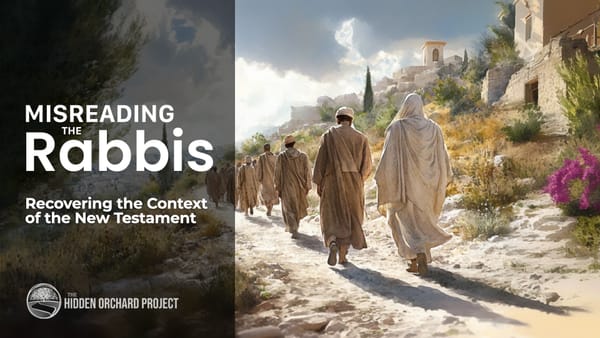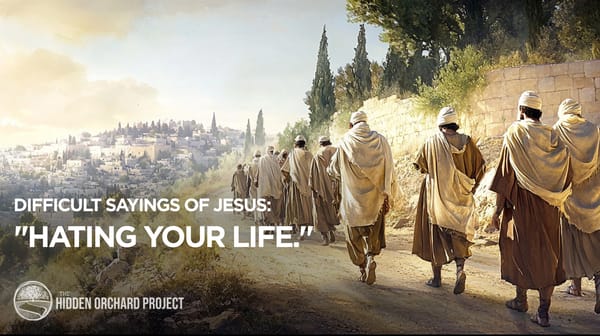Burial Shrouds and Customs in the Gospel Accounts
On Easter Sunday, it is customary to see the crosses out front of your local Churches draped in a white, or linen sash. Have you ever wondered where this idea originated? Believe it or not, it is derived from within the Jewish oral tradition of the first century.

On Easter Sunday, it is not unusual to see the cross out front of your local Church draped in a white linen sash. Have you ever wondered where this tradition originated?
What if I told you it likely derived from the burial customs described detailed in the Jewish oral tradition, recorded in the Talmud? I'll explain.
Burial Customs
In the first century, poverty was widespread throughout the land of Israel. The Roman Empire was known for its efficient tax collection system, which allowed for the extraction of significant revenue from their territories. Thus, the Roman occupation came with a heavy price for the Jewish people.
At times, the sheer cost of living would leave little resources for critical life-cycle events like the burial of loved ones, having children, and various Temple offerings. Particularly in the case of funeral costs, poorer families would find themselves in financial straits to observe the basic requirements for a funeral.
If you've ever had the experience of managing the costs of a deceased loved one, you are aware modern burial practices can average $10,000. These can be much higher when salespeople seize the opportunity to upsell grieving family members.
To some extent, this seems this may have been a problem in the early first century, a situation the Rabbis went to great lengths to prevent. Overtaken by emotion, a family would incur a significant amount of debt burying a loved one in the best they could, (and also could not) afford.
The goal of the Rabbis was to enable the fulfillment of this mitzvah (commandment) for both the wealthy and the poor alike, bringing mercy on those who were financially limited. In most cases, it was the wealthy who were price-capped, or constrained to opt for a less-expensive funeral. This was a thoughtful solution that provided dignity for the poor.
For example, regarding face coverings for the deceased, we read:
... at first they would uncover the faces of the wealthy who passed away and cover the faces of the poor, because their faces were blackened by famine. And the poor were embarrassed because they were buried in a different manner. The Sages instituted that everyone’s face should be covered, due to the honor of the poor. - Talmud Moed Katan 27a
It is worth mentioning here, many of the customs for Jewish burial are thoughtfully intended to care for the soul of the deceased, (Met/Metah). After having lived a lifetime in a body, the soul will often undergo great distress as it hovers around the body for 3-7 days. A face covering is thus intended to help alleviate some of this disorientation.
Linen Burial Shrouds
Tragically, at one point, burying the dead became such a financial burden on poorer families, many resorted to leaving the bodies [of their loved ones] by the roadside in hopes that someone [else] would have mercy and bury them.
In the Talmud, we read;
Initially, the funeral expenditures for the deceased were more taxing for his relatives than his death, as the burials were opulent, until it reached a point where people would abandon the deceased and flee...
- Ketubot 8
In the first century, Rabban Gamliel¹, leading by example, instructed that he himself be buried in simple linen clothing. This practice still remains today.
This continued until Rabbi Gamliel came and conducted himself in a self-deprecatory manner, instructing the people that they were to take him for burial in plain linen garments. And all the people conducted themselves following his example and instructed their families to take them for burial in plain linen garments. Rav Pappa said: And today, everyone is accustomed to burying the dead in plain garments, even in rough cloth worth one zuz. - (ibid)
Past and Future
The precedent for Rabban Gamliel's ruling may have been the linens worn by the High Priest on Yom Kippur as described in the Torah. This also signals repentance and the future resurrection of the dead. In fact, much of the burial customs in Jewish law seem to be designed with these ideas in mind, preparing the deceased to once again stand up and walk into the Kingdom.
The linen garments Jesus wore when placed in the tomb have been recorded in all four Gospels².
Then they took Jesus’ body and wrapped it, with the aromatic spices, in strips of linen cloth according to Jewish burial customs. - John 19:40
This, along with the descriptions of processes to prepare the body, and the careful observance of the "Festival" and Shabbat indicate a continued reliance upon the institution of the Jewish oral Torah³ by the Apostolic community.
Learn About the Oral Torah

Notes:
¹ See Moed Katan 27b:
Likewise, at first taking the dead out for burial was more difficult for the relatives than the actual death, because it was customary to bury the dead in expensive shrouds, which the poor could not afford. The problem grew to the point that relatives would sometimes abandon the corpse and run away. This lasted until Rabban Gamliel came and acted with frivolity, meaning that he waived his dignity, by leaving instructions that he be taken out for burial in linen garments. And the people adopted this practice after him and had themselves taken out for burial in linen garments. - Moed katan 27b
² Matthew 27:59; Luke 23:53; John 19:40; Mark 15:46





